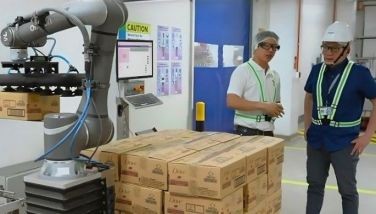Utan Bisaya the fountain the fountain of youth
CEBU, Philippines - Have you ever heard of utan bisaya? Have you ever wondered why people always look and ask for it in small carenderias around town? And have you ever thought why most eateries in the city always have a cauldron of steaming utan bisaya besides the usual humba, afritada, menudo, adobo, pinirito, tinuwa, sinugba, balbacua and kinupusan displayed near the counter?
“Naa moy utan bisaya, nang?â€(Do you have Visayan Vegetable Soup, sister?) Perhaps you may have heard this yourself one time while waiting for your turn at the carenderia across the street and eyeing the last chicken adobo that did not go to you but to the guy standing in front of you. Admit it, you hated that guy because he made you settle with a leathery lumpia which totally ruined your day. Now, forget that guy and the chicken adobo and answer my question. If you can still remember the person whom you heard asking for utan bisaya, would I be correct in saying that that person was an old lady or an elderly man or a worker from a nearby construction site? Based on experience, people who look for this particular soup are mostly old (30-70 years old usually). What do you think makes them crave for it? Why don’t teenagers ask for it? Do old people know something teenagers do not?
Well, if you’ll try to dissect utan bisaya the way you dissect the frog in the lab, you’ll discover how the ingredients like gabi, kalbasa, okra, alugbati, kamunggay, tangad, and sikwa are carefully mixed together to produce a very healthy and nutritious soup. Take note of the word “carefully†because if you’ll add other vegetables to the ones I mentioned, the taste changes and probably also its nutritional balance. Try adding ampalaya to it or sayote or even talong and nobody will like it. On the other hand, if one ingredient is missing in the mix, the taste changes too . Try to include gabi or agbati in the mix and you’ll understand what I mean. One reason why old people look for it is that this soup dubbed as utan bisaya is so balanced that you can literally feel the nutrients seeping from your stomach through your veins into your bloodstream. Your eyes grow big as you take the soup in and you sweat all over. It’s like Jesus has just healed you from a sickness that you thought was hopeless. As you chew on the fibrous gabi and the smooth kalbasa and the slippery okra, the joy is so overwhelming you will want to share the experience with everyone. Whoever invented this soup must be a genius.
People say this soup is best for athletes. I would say that’s true. And not only for athletes but for all (aren’t we athletes too in our own rights?). What do athletes do? Run? Swim? Walk? Sprint? Climb? Aren’t we ordinary people doing these things every single day of our lives? So, crisp and clear, the soup is for everyone! In fact, from personal observation, I had classmates from the province who were way stronger than us who come from the city. They bested us in almost all physical obstacles in our P.E. classes. During intramurals, they were the ones who got the most medals. I jokingly asked one provinciano classmate his secret and he jokingly told me it’s utan. “Kaog utan, uy!†That was what he told me. Each time I go south or north, I would look out the window of the bus and there I always find the secret ingredients of utan bisaya growing in abundance at the side of the road.
My classmate is right. Most times, they eat vegetables because it’s the only thing available. Pork and chicken would show up on the table only when there’s fiesta, or birthday, or when a long lost relative from the big city arrives, or in a dream. The vegetables are just there growing in front of their small hut. Sometimes the vines of the squash or sweet potato would crawl farther to the back of the hut to join the okra and the eggplants or get entangled with another vine like paliya (bitter gourd) or white squash. Up front, an armada of tall malunggay plants are carefully lined up to create a kind of fence that separates the hut from the highway or a back road (probably planted a long time ago by the grandmother of the family). The owner sometimes would ask a passerby to pluck some healthy leaves for her because she can’t reach them. Then she would bless him with a smile and a warm encouraging pat on the shoulder.
Like dwarves at the foot of the giant malunggay plants, the tomatoes are bent like old men because the fruits are getting heavier and heavier each single day. In the morning, they glitter under the rays of the sun which makes the owner happy because that would mean her tomatoes are healthy. In the afternoon, the owner with her little basket plucks them for the egg salad later in the evening or maybe for the omelet the next day. But it’s not all tomatoes in that small piece of land because there are also monggo invisible to anyone passing by. If you have not seen a monggo plant yet you would mistake it as just another weed or bramble. Co-existing in that small garden with shiny, colorful (green, yellow, red) tomatoes, it is understandable that the monggo plant gets less attention. You cannot blame the monggo plant for that. It’s just that besides its green leaves and dark pods it does not show any other color at all. But they’re as nutritious as the tomatoes.
Underground, the ginger crawls to the sides and down. You would not know that unless you watch the owner of the garden harvest them. What you see on surface level are just the bamboo-like leaves. Same thing goes to all the other root crops or tubers that you like: gabi and ube. Crawling up the big leaves of the gabi could be the reddish-purple stem of the alugbati (Basella alba) that carries its thick, semi-succulent, heart-shaped leaves high in vitamin A, vitamin C, iron, and calcium. Then, there’s the tangad (lemongrass) growing heavily at one corner of the garden. This kind of grass may look unimportant to you but mind you this grass is said to lower blood pressure. If you get off the bus and stand there for a while to examine the garden, you would discover other vegetables that are equally nutritious as the ingredients found in utan bisaya. This is what people in the city are missing. Most city people don’t have gardens because that little space is used as garage for their prized cars or because they live in dorms or apartments. But this should not be a reason not to enjoy utan bisaya.
Remember utan bisaya is for everyone. Vegetables from the province are being transported every day to the city so that the city people can have their share of utan bisaya anytime they like. Like the boys and girls from the province who are faster, taller, and stronger because they eat utan bisaya, you too can enjoy what they have been enjoying all this time. Gabi or taro root has almost three times the dietary fiber important for proper digestion. It is an excellent source of potassium, calcium, vitamin C, vitamin E and B vitamins, magnesium, manganese, and copper. Kalbasa or yellow squash is rich in vitamin C and a good source of magnesium, vitamin A, fiber, folate, copper, riboflavin, and phosphorus. The magnesium it gives has been shown to reduce the risk of heart attack and stroke. Alugbati or Malabar spinach is rich in vitamin A, calcium, potassium, and folic acid. Vitamin A is important to the immune system because it creates white blood cells that battle bacteria and viruses. Malunggay or Moringa Oleifera combats malnutrition because of its vitamins A, B, and C plus calcium, iron, and protein content. Okra or gumbo helps normalize blood sugar level. Sikwa or sponge gourd helps lose weight due to its low calorie content. Best defense against obesity. Last but not least, the tangad or lemongrass. One gram of lemongrass contains enough Citral to prompt cancer cells to self destruct.
With all the vitamins and minerals utan bisaya can provide, no wonder old folks keep asking for it. The soup really is the fountain of youth.
Have a bowl of utan bisaya! (FREEMAN)
- Latest






























